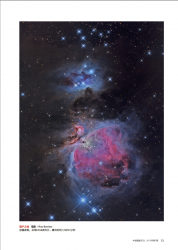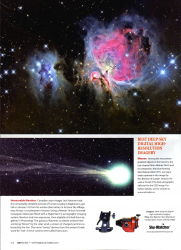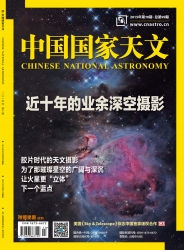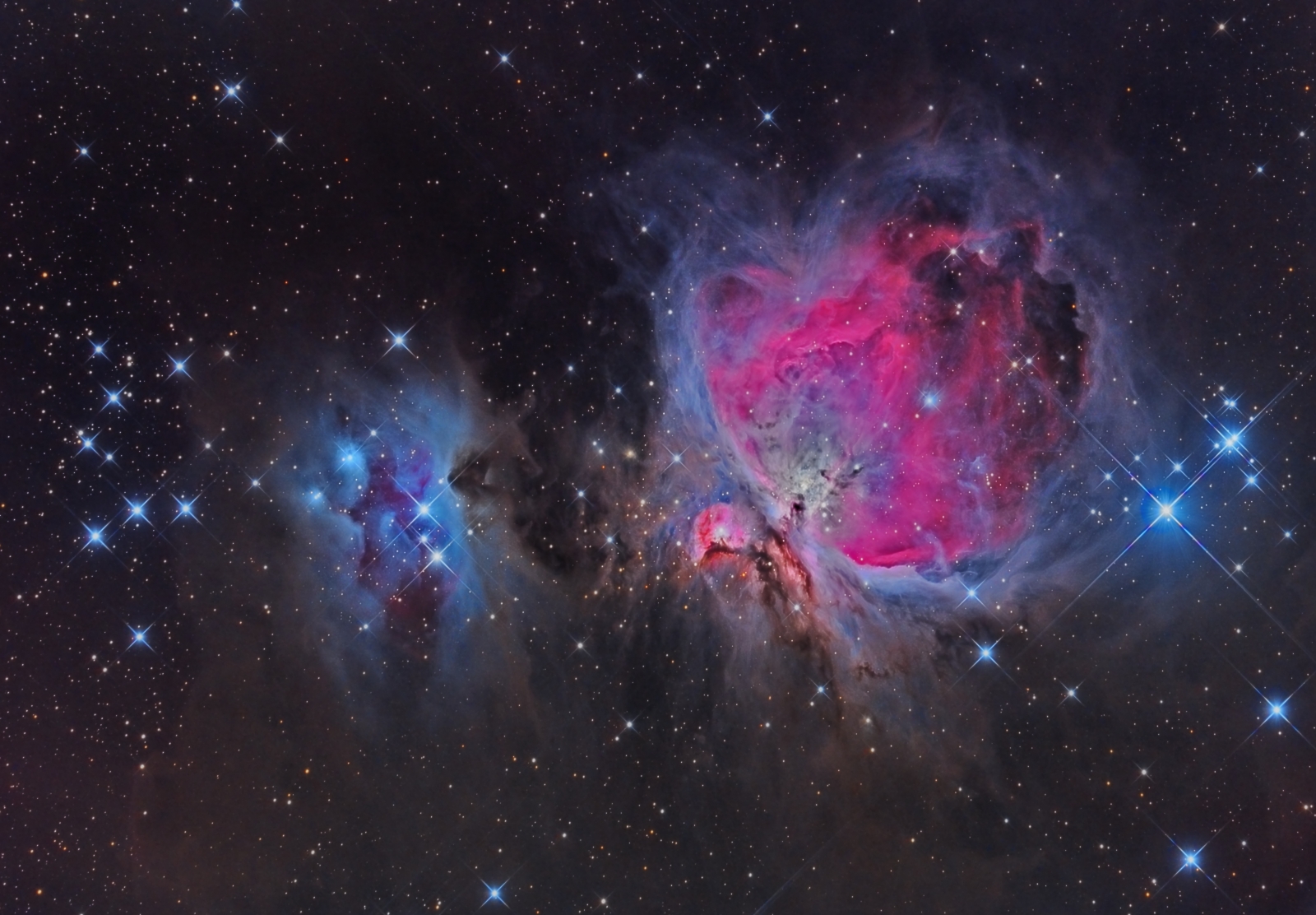Orion’s Sword
Click image for full size version
February 5, 2015; published in SkyNews Magazine, May/June 2015 edition and Chinese National Astronomy Magazine, July 2015; Winner, Deep Sky High Resolution Imaging, 13th Annual SkyNews Photo of the Week Competition, Cover of Chinese National Astronomy Magazine, October 2015


 Orion’s Sword might be my favourite single star field in the sky, but I could probably say that about a dozen other objects. There’s a lot going on in this field. The large object in the right side of the image is the Orion Nebula, M42. Just left of centre is the Running Man Nebula, NGC1977. These objects contain both emission (reddish) and reflection (bluish) ndubla components. There are also star clusters,and lots of interstellar dust and soot visible in this image. Together, this group of objects makes up Orion’s sword, which hangs from his belt in the southern sky early in the evening at this time of year. If you look at the core of the Orion Nebula, you can see the quadruple star theta Orionis (known as “The Trapezium”) which is well resolved in this image.
Orion’s Sword might be my favourite single star field in the sky, but I could probably say that about a dozen other objects. There’s a lot going on in this field. The large object in the right side of the image is the Orion Nebula, M42. Just left of centre is the Running Man Nebula, NGC1977. These objects contain both emission (reddish) and reflection (bluish) ndubla components. There are also star clusters,and lots of interstellar dust and soot visible in this image. Together, this group of objects makes up Orion’s sword, which hangs from his belt in the southern sky early in the evening at this time of year. If you look at the core of the Orion Nebula, you can see the quadruple star theta Orionis (known as “The Trapezium”) which is well resolved in this image.
Tekkies:
SBIG STL-11000M camera, Baader LRGB filters, 10″ f/3.6 ASA astrograph, MI-250 mount. Guided with internal guider in main camera. Acquistion, guiding, calibration, registration and integration all done using Maxim-DL. Focusing with FocusMax. Shot from my SkyShed in Guelph, Ontario. No moon, average transparency and seeing.
Colour data was obtained from 4x2mL, and 2x2m R,G and B (total of 18m LRGB). Luminance (brightness) data was obtained from a total of 80m of 10s, 30s, 60s and 5m exposures (between 13-16 of each). Total exposure time was 98m
Dynamic Background Extraction, Colour Calibration, Stretch, ACNDR noise reduction (small scale), reset black point, curves, saturation were all applied to the colour image.
The luminance image was created as follows: A separate luminance frame was made for each exposure length (10s, 30s, 60s and 5m). Each of these was processed in PixInsight with Dynamic Background Enhancement. They were then aligned to each other and combined using the HDRCombine tool in PixInsight. The HDR image was deconvolved (40 iterations with local and global deringing, on the bright areas of the image only) and then stretched. HDR Wavelets was applied using 4 wavelet layers. Then small scale noise was removed with ACDNR.
The HDR luminance was combined with the colour image using the ColourSpaces command with chromatic noise reduction. The histogram was stretched (blackpoint only) and contrast was enhanced using the Curves tool. The DarkStructureEnhance script in PixInsight was then applied.
ExponentialTransformation was applied to boost the background. A luminance mask was made and used with TGV Denoise to reduce noise in the background and then the same mask was inverted to boost saturation in the nebula and stars slightly. Luminance was extracted and HDRLinearTransform was applied at a 4 layer scale, with residual unchecked. The resulting file was used as a mask to boost saturation in the faint stars. Image contrast and brightness were adjusted with curves.
Image scale is about 2″/pixel for this camera/telescope combination.







very beautiful detail and framing, as well as colorimetric Very good
Hi Ron, the Orion Nebula is one of my favorite objects in the sky to see. I often show it to friends and family. With my telescope it is only a whitish smudge. The colors captured in your photograph are marvelous. Thanks for sharing it.
Steve
Thanks Steve. I’m glad you like it and very nice to hear from you.